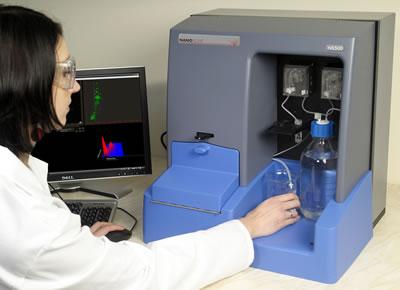Members Login

Channels
Special Offers & Promotions
NanoSight announces a new generation nanoparticle characterisation system
 NanoSight, manufacturers of unique nanoparticle characterisation technology, announces the release of the NS500 system. The NS500 incorporates new hardware and software to deliver NanoSight's growing capability in particle-by-particle characterisation in an automated package. The first system is in use at the University of Oxford in the Nuffield Department of Obstetrics and Gynaecology of the John Radcliffe Hospital as part of a program supported by the Wellcome Foundation.
NanoSight, manufacturers of unique nanoparticle characterisation technology, announces the release of the NS500 system. The NS500 incorporates new hardware and software to deliver NanoSight's growing capability in particle-by-particle characterisation in an automated package. The first system is in use at the University of Oxford in the Nuffield Department of Obstetrics and Gynaecology of the John Radcliffe Hospital as part of a program supported by the Wellcome Foundation.NanoSight's technology, known as Nanoparticle Tracking Analysis (NTA), provides a high-resolution particle size distribution, and not by DLS (dynamic light scattering). NTA detects individual particles as small as 20nm and, in real time, simultaneously tracks and sizes whole populations. The result is a particle size distribution that provides researchers with an over view of their samples showing everything in the whole range 20 - 1,000nm. NTA also provides count and concentration, together with a unique view which validates these results.
The NS500 adds fluorescence capability, enabling the user to tune into individual particles, with sensitivity to detect individual quantum dots whilst eliminating background interference of other particles and media. Standard beads may be used to bind to single particles for optimum study.
The fluid handling capability of NS500 provides the user with auto sample presentation and in-situ cleaning. It is now a routine process to clean the cell with the ability to purge, flush and load samples through user-customisable software. Dilution may also be optimised then controlled in this way. Ease of use is further enhanced with a motorised focus function to readily home in on the particles under study. In direct response to user feedback this is augmented with an indexed motorised stage, controlled through the software and providing excellent repeatability in positioning. The temperature control of the cell offers a broad range (15?C to 55?C) and programmable temperature cycling, with rapid attainment of set-point facilitating faster sample measurement and turnaround.
The goal of the NS500 is to provide an easy-to-use, reproducible platform applicable for specific and general nanoparticle characterisation use. So whether the application is to control size in nanoparticle development, provide rapid virus titer or measure the kinetics of protein aggregation, the NS500 system is the solution.
To learn more about nanoparticle characterisation using NTA, please visit the company's website (www.nanosight.com) and register for the latest issue of NanoTrail, the company's electronic newsletter.
Media Partners


